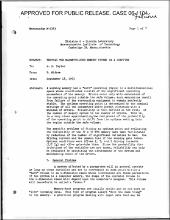| dc.contributor.author | Widrow, B. | en_US |
| dc.date.accessioned | 2009-05-09T05:08:17Z | |
| dc.date.available | 2009-05-09T05:08:17Z | |
| dc.date.issued | 1953-09-18 | en_US |
| dc.identifier | MC665_r06_M-2383.pdf | en_US |
| dc.identifier.uri | http://hdl.handle.net/1721.3/39449 | |
| dc.description.abstract | A working memory has a "safe" operating region in a multidimensional space whose coordinates consist of the significant operating parameters of the memory. Errors occur only with excursions of the operating point outside the safe volume; such excursions result from failure of the surrounding equipment to remain perfectly stable. The optimum operating point is determined by the nominal settings of all the parameters which permit operation with a minimum of errors. Reliability is then defined as the ratio of the number of memory cycles to the number of errors. This is, to a very close approximation,the reciprocal of the probability of the operating point to drift from its optimum setting into the region outside the safe volume.
The specific problems of finding an optimum point and evaluating the reliability of the 32 x 32 MTC memory have been facilitated by reduction of the number of significant variables to two: the driving current and the common bias of the sensing gate tubes. Optimum conditions were 475-ma X, Y, and Z driving currents (1/2 Im) and -30-v gate-tube bias. Since the probability distributions of the variables are not known, reliability can only be evaluated by optimizing the adjustments of the system and maintaining count of its errors. | en_US |
| dc.language.iso | en | en_US |
| dc.publisher | Lincoln Laboratory - Division 6 | en_US |
| dc.relation.ispartofseries | MIT DIC 6889 | en_US |
| dc.relation.ispartofseries | Project Whirlwind Memo M-2383 | en_US |
| dc.relation.ispartofseries | Project Whirlwind Collection, MC665 | en_US |
| dc.title | Testing the Magnetic-Core Memory System in a Computer | en_US |
| dc.type | Technical Report | en_US |
